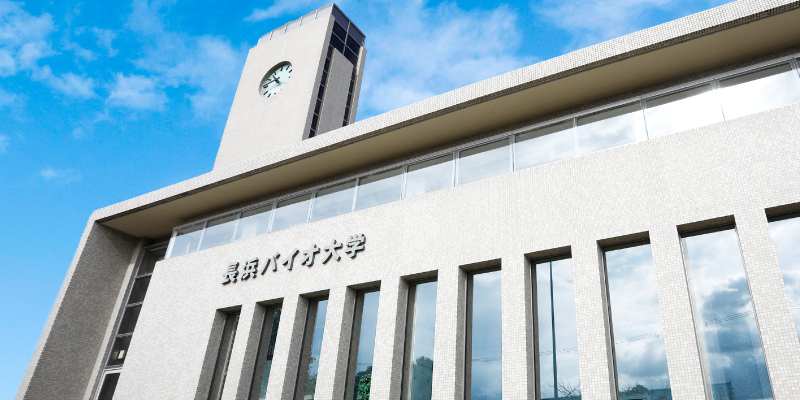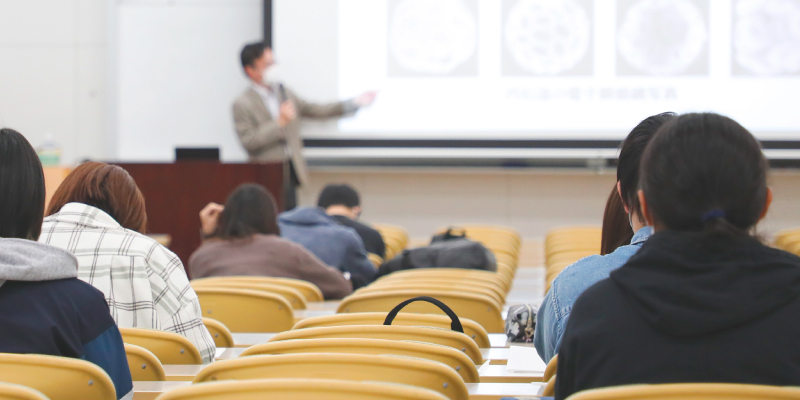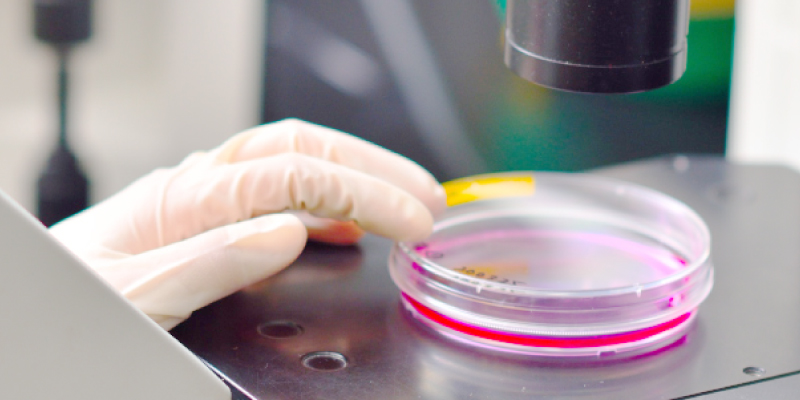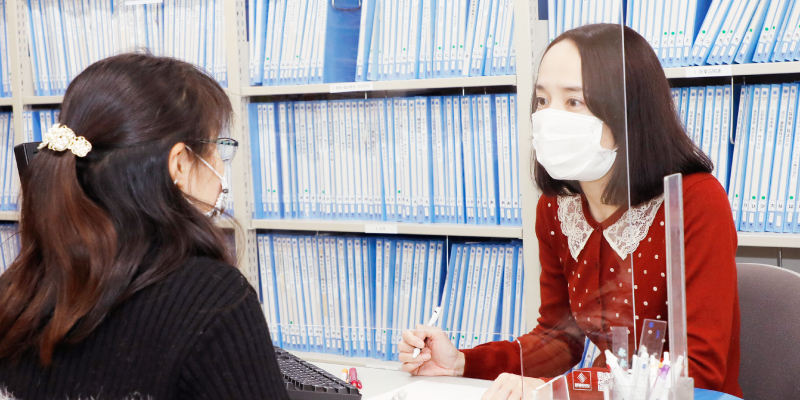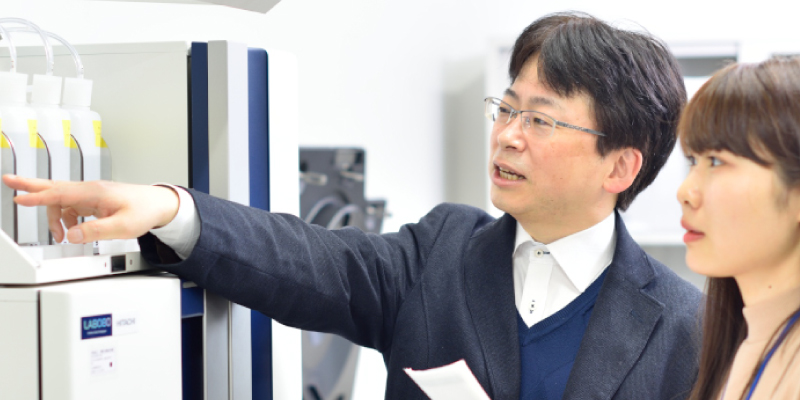フロンティアバイオサイエンス学科
 石川 聖人(いしかわ・まさひと)
石川 聖人(いしかわ・まさひと)
Masahito Ishikawa
専門分野/細菌分子遺伝学、生物工学
研究キーワード/合成生物学、人工細胞、脱炭素、バイオプロダクション、ゲノムライティング
職位:准教授
学位:博士(工学)(名古屋大学)
- ・名古屋大学大学院工学研究科 博士後期課程修了
- ・名古屋大学大学院工学研究科 研究員、東京大学大学院工学系研究科 特任研究員、東京大学先端科学技術研究センター 特任助教、名古屋大学大学院工学研究科 助教を経て本学へ
研究テーマ
効率と利便性を追求してきた前世紀の負債である環境問題を解決していくことは、今世紀以降の科学・技術の課題であると考えます。目下の課題は二酸化炭素排出量の削減、脱炭素化でしょう。微生物細胞を利用するバイオテクノロジーは二酸化炭素排出の少ないクリーンな印象がありますが、必ずしもそうではありません。私達は、真に環境問題の解決に資するバイオテクノロジーの開発を目指し、微生物工学・遺伝子工学・タンパク質工学を駆使した合成生物学研究を推進します。現在取り組んでいる研究テーマは以下になります。
(1)新しいゲノム操作技術の開発
バイオ産業に活用されている生物のゲノム配列を、細胞機能を最大限に発揮するように設計されたゲノム配列へと書き換えることができれば、製品の製造・精製に係るエネルギーを大幅削減でき、脱炭素化に貢献することができます。これを実現する技術としてゲノム編集は重要視されていますが、既存技術は遺伝子破壊の効率は高いものの、望みの配列へと書き換える効率は十分とは言えません。私達は、細菌の持つリピート配列の安定化機構に着目して、新しいゲノム操作技術の開発を目指しています。これまで細菌のリピート配列が関わる生体分子からは、制限酵素・TALEN・CRISPR-Cas9といった生命科学とバイオテクノロジーを支える技術が産み出されています。当該分野を革新する新技術も細菌のリピート配列を取り巻く生物機能から開発されることでしょう。
(2)ファイバータンパク質の分子紡績
脱炭素化社会の実現に向けて、原料を石油に依存しないタンパク質性繊維が注目を集めています。合成生物学の発展に伴い、繊維状タンパク質を大量に微生物生産できるようになってきたことも注目されている要因の一つです。私達は、独自に発見したナノファイバータンパク質を微生物細胞内で大量に得ることに成功しています。本研究テーマでは、これをつなぎ合わせて繊維状にする技術の開発を目指しています。すなわち、短い繊維を撚り合わせて長い糸にする紡績の如く、ナノファイバータンパク質を分子紡績することを目指しています。
(3)高速増殖細菌の実験自動化
現在の生命科学研究とバイオテクノロジーでは、DNAコンストラクトの構築とタンパク質生産の工場として大腸菌が活用されています。大腸菌はわずか20分で2倍に増えることから、短期間に多くの試行を行うことができます。そのため、大腸菌はバイオ研究者・技術者に長らく愛用されてきましたが、バイオ関連試薬・機器の充実、DNA合成の自動化、流通の高速化により、むしろ大腸菌の増殖を待つ時間が研究・開発の律速となってきています。では、大腸菌よりも早く増殖する細菌を利用しようという発想が浮びますが、そこまで話は単純ではありません。大腸菌の増殖速度は私達の生活サイクルにフィットしてしまっているのです。大腸菌は、夕方の帰り際に育て始めれば、翌日朝には丁度よい数に増えています。しかし、大腸菌よりも増殖の早い細菌の場合は、夕方に育て始めると深夜もしくは翌日早朝に丁度よい数になるため、回収する実験者・作業者にとって負担となります。そこで、私達は大腸菌よりも増殖速度の早い細菌(高速増殖細菌)を用いた実験を機械化・自動化することにより、実験者・作業者に負担をかけることなく生命科学とバイオテクノロジー研究を加速させることを目指します。
| 研究の応用領域 | 産官学連携で求めるパートナー |
|---|---|
| ・微生物細胞の分子育種 ・微生物生産の効率化 ・遺伝子操作ツール開発 |
・国内外の大学 ・研究機関 ・創薬関連企業 ・食品・化成品・医薬品等のバイオプロダクションに取り組んでいる企業 ・バイオ機器メーカー ・大学、国・地方自治体の基礎研究機関 |
Topics of research
Solving environmental problems, a liability of the last century pursuiting efficiency and convenience, is a challenge for science and technology in this century and beyond. The issue at hand will be the reduction of carbon dioxide emissions. Biotechnology with microbial cells seems clean with low carbon dioxide emissions, but this is not necessarily the case. We promote synthetic biology research using microbial engineering, genetic engineering, and protein engineering with the aim of developing biotechnology that truly contributes to solving environmental problems. The research themes we are currently working on are as follows.
(1) Development of new genome manipulation technologies
If the genome sequences of organisms used in the bioindustry could be rewritten into genome sequences designed to maximize cellular functions, it would be possible to drastically reduce the energy used in the manufacture and purification of products, thereby contributing to decarbonization. Genome editing is a fascinating technology to realize this goal, but existing technologies are highly efficient in gene knockout, but not efficient enough to rewrite the desired sequence. We are aiming to develop a new genome manipulation technology by focusing on the stabilization mechanism of bacterial repeat sequences. Biomolecules associated with bacterial repeat sequences have so far yielded technologies that support life science and biotechnology, such as restriction enzymes, TALEN, and CRISPR-Cas9. New technologies that will revolutionize the field will also be developed from the biological functions surrounding bacterial repeat sequences.
(2) Molecular spinning of fiber proteins
Protein-based fibers that do not depend on petroleum as a raw material have attracted attention toward the realization of sustainable society. The advance in synthetic biology has facilitated this trend because it has become possible to produce large quantities of fibrous proteins by microorganisms. We have also succeeded in obtaining large amounts of nanofiber proteins, which we originally discovered, in microbial cells. In this research theme, we aim to develop a technology to connect these nanofiber proteins together and make them into fibers. In other words, we are aiming at molecular spinning of nanofiber proteins, similar to the spinning of short fibers into long threads by twisting them together.
(3) Automation of experiments for fast-growing bacteria
In current life science and biotechnology research, E. coli is utilized as a factory for DNA constructs and protein productions. Since E. coli divides in just 20 minutes, many trials can be performed in a short period of time. Hence, E. coli has long been a favorite of biochemists and life scientist. However, due to the advance in reagents and equipment for biotechnology, automation of DNA synthesis, and their faster distribution, the time spent waiting for E. coli cell growth has rather become the rate-limiting step in research and development. The idea of using bacteria that multiply faster than E. coli comes to mind, but the story is not very simple. The growth rate of E. coli fits into our life cycle. If we start growing E. coli cells when we leave a laboratory in the evening, the number of E. coli cells will increase to just the right number the next morning. However, if you start growing for bacteria growing faster than E. coli in the evening, they will be at the right number at midnight or early morning the next day, which is a burden for an experimenter/worker who collects them. Therefore, we aim to accelerate life science and biotechnology research without burdening experimenters and workers by automating experiments using bacteria growing faster than E. coli.
主な業績論文等
- Masahito Ishikawa, Takaaki Kojima, and Katsutoshi Hori “Development of a biocontained toluene-degrading bacterium for environmental protection”, Microbiol Spectr, e0025921 (2021)
- Yan-yu Chen,† Yuki Soma,† Masahito Ishikawa,† Masatomo Takahashi, Yoshihiro Izumi, Takeshi Bamba, and Katsutoshi Hori “Metabolic alteration of Methylococcus capsulatus str. Bath during a microbial gas-phase reaction” Bioresour Technol, 330, pp.125002, (2021) †Authors equally contributed to this work.
- Masahito Ishikawa,* Kazuki Kawai, Masahiro Kaneko, Kenya Tanaka, Shuji Nakanishi, and Katsutoshi Hori* “Extracellular electron transfer mediated by a cytocompatible redox polymer to study the crosstalk among the mammalian circadian clock, cellular metabolism, and cellular redox state” RSC Advances, 10(3), 1648-1657 (2020)
- Kosaku Noba,† Masahito Ishikawa,† Atsuko Uyeda, Takayoshi Watanabe Takahiro Hohsaka Shogo Yoshimoto, Tomoaki Matsuura,* and Katsutoshi Hori* “Bottom-up creation of an artificial cell covered with the adhesive bacterionanofiber protein AtaA”, J Am Chem Soc, 141, 19058-19066 (2019) †Both authors equally contributed to this work.
- Masahito Ishikawa, Sho Yokoe, Souichiro Kato, and Katsutoshi Hori “Efficient counterselection for Methylococcus capsulatus (Bath) using a mutated pheS gene”, Appl Environ Microbiol., 84, e01875-18, (2018)
- Masahito Ishikawa, Yuya Tanaka, Risa Suzuki, Kota Kimura, Kenya Tanaka, Kazuhide Kamiya, Hidehiro Ito, Souichiro Kato, Toshiaki Kamachi, Katsutoshi Hori, and Shuji Nakanishi, “Real-time monitoring of intracellular redox changes in Methylococcus capsulatus (Bath) for efficient bioconversion of methane to methanol” Bioresour. Technol., 241, 1157-1161, (2017)
- Masahito Ishikawa, Shogo Yoshimoto, Ayumi Hayashi, Junichi Kanie, and Katsutoshi Hori “Discovery of a novel periplasmic protein that forms a complex with a trimeric autotransporter adhesin and peptidoglycan” Mol. Microbiol., 101, 394-410, (2016).

